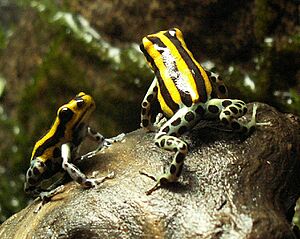Sira poison dart frog facts for kids
Quick facts for kids Sira poison dart frog |
|
|---|---|
 |
|
| Conservation status | |
| Scientific classification | |
| Synonyms | |
|
Dendrobates sirensis Aichinger, 1991 |
The Sira poison frog (Ranitomeya sirensis) is a small, colorful frog. You can find it in the Amazon rainforests. These forests are located in northern Bolivia, western Brazil, and eastern Peru.
Some people keep Sira poison frogs as pets. However, they are known to be a bit tricky to care for. This is because they are rare. Also, their babies, called tadpoles, need special attention.
Contents
About Their Poison
Like many other poison dart frogs, the Sira poison frog can be a little bit toxic. Its skin makes tiny amounts of chemicals called pumiliotoxins. These chemicals cover the frog's skin.
If you touch the frog without being careful, these chemicals can cause mild pain. They might also cause small muscle twitches. If an animal were to eat the frog, the effects could be more serious.
However, the Sira poison frog is not as dangerous as some other poison dart frogs. It makes a milder type of toxin in very small amounts. This is partly because of its small size. So, instead of relying on strong poison, these frogs mostly use their speed. They are also good at hiding quickly in leaves or thick plants to stay safe.
Why They Lose Poison in Captivity
Interestingly, Sira poison frogs lose their poison when they are kept as pets. Scientists believe this happens because they no longer eat certain insects. In the wild, these frogs get their toxins from the tiny creatures they eat.
For example, some very poisonous frogs get their strong toxins from specific types of beetles. The Sira poison frog is not as toxic. So, scientists think its poison comes from a different, still unknown, tiny creature it eats in its natural home.
Where They Live and How We Protect Them
Sira Frog Habitat
The Sira poison frog lives in tropical forests. These can be found in mountains or lower areas. They like moist forests that have grown back after being disturbed. They can even live in places where humans have changed the habitat a little bit.
Protecting Sira Frogs
One big problem for these frogs is the illegal pet trade. People sometimes collect them from the wild to sell as pets. This is especially a threat to groups of frogs that live in isolated areas. These isolated groups often have unique and beautiful colors, which makes them more desirable to collectors. Protecting their homes and stopping illegal trade helps these frogs survive.


